The sight of a parrot puffing up can evoke various emotions, from curiosity to concern, in bird enthusiasts and pet owners.
This distinctive behavior, where the bird fluffs its feathers, carries a multifaceted significance rooted in the parrot’s natural instincts and communication.
Understanding what does it mean when a parrot puffs up involves deciphering a complex language that includes expressions of contentment, physical well-being, environmental adaptation, and even signals related to mating or potential distress.
This exploration delves into the nuanced meanings behind a puffing parrot, shedding light on the diverse factors that contribute to this feathered phenomenon.
Unlocking the secrets of why parrots puff up enables caregivers to respond appropriately, fostering a deeper connection and ensuring the optimal health and happiness of their avian companions.
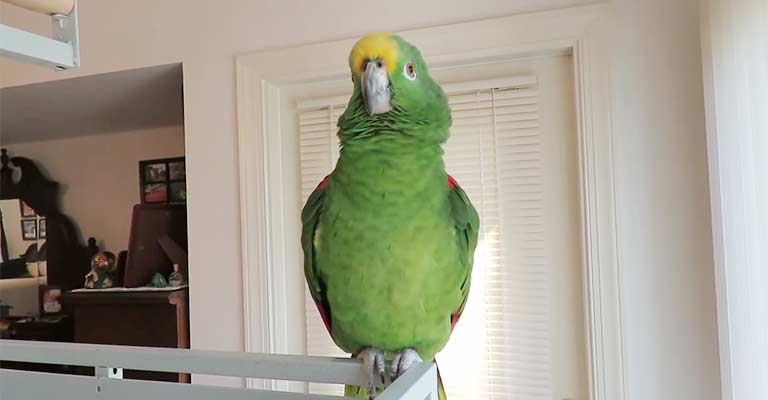
What Does It Mean When A Parrot Puffs Up?
When a parrot puffs up, it can be a sign of various states or behaviors, depending on the context.
Here’s what does it mean when a parrot puffs up:
Thermoregulation
When a parrot puffs up, it often indicates a natural response to regulate body temperature. By trapping more air in their feathers, parrots create an insulating layer, helping them stay warm in cooler environments.
If the environment is cold, and the bird appears otherwise healthy, puffing up is a sign that the parrot is adjusting to maintain its body heat.
Contentment and Relaxation
Parrots may puff up as a sign of contentment and relaxation. When a parrot feels safe, secure, and comfortable, it may puff up its feathers as a form of relaxation, akin to humans wrapping themselves in a cozy blanket.
This behavior is often seen when the parrot is perched in a familiar and secure environment.
Illness or Discomfort
On the flip side, puffing up can also be an indication of illness or discomfort. Sick parrots may puff up to conserve energy or due to weakness.
If puffing up is accompanied by other signs of illness, such as lethargy, changes in appetite, or unusual droppings, immediate veterinary attention is necessary to identify and address the underlying health issue.
Fear or Stress
Parrots may puff up when they are fearful or stressed. This behavior is a defensive mechanism to make themselves appear larger and potentially intimidating to perceived threats.
Identifying and alleviating sources of stress, such as loud noises or unfamiliar people or animals, can help reduce puffing due to fear.
Mating or Courtship Display
During the mating season, some parrots, particularly males, may puff up as part of a courtship display. Puffing up can make the bird appear larger and more attractive to a potential mate.
If your parrot exhibits this behavior, it may be expressing its natural instincts related to mating.
Naptime or Sleeping Position
Parrots may puff up when they are taking a nap or preparing to sleep. Puffing up provides additional insulation and warmth during periods of rest. This is a normal and healthy behavior, especially during the evening when parrots naturally settle down for the night.
Social Bonding
Puffing up can be a social behavior, expressing a sense of well-being and bonding. Parrots in a group or pair may puff up as a way to reinforce social connections.
This behavior is often observed when parrots are content in the presence of their human or avian companions.
Understanding the context in which a parrot puffs up is crucial for interpreting its meaning. Regular observation of your parrot’s behavior, coupled with awareness of its environment and overall health, enables you to respond appropriately to their needs.
If there are concerns about your parrot’s health or well-being, consulting with an avian veterinarian is advisable.
Which Other Bird Puffs Up?
Here’s which other bird puffs up:
Cockatiels (Nymphicus hollandicus)
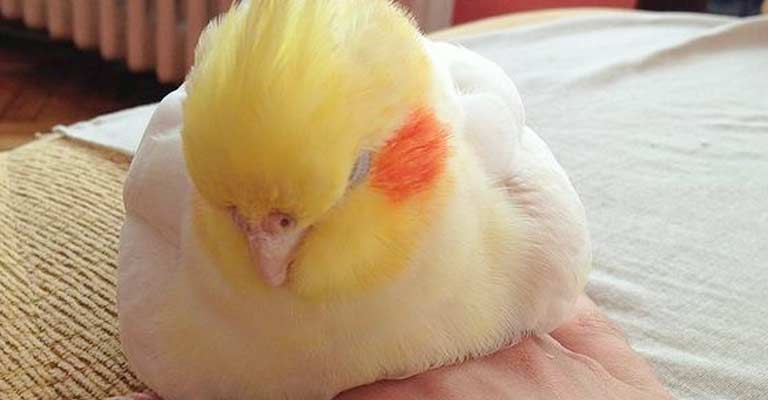
Cockatiels are renowned for their charming personalities and distinctive crest. Similar to other parrot species, cockatiels puff up as a way to regulate body temperature, express contentment, or exhibit relaxation.
During periods of rest, especially when they are perched in their cage, cockatiels may puff up their feathers for added insulation.
Canaries (Serinus canaria)
Canaries, known for their melodious songs and vibrant plumage, may puff up for various reasons. Puffing up in canaries can be a sign of comfort, contentment, or response to environmental factors such as changes in temperature.
Observing their behavior alongside their singing patterns helps in understanding the specific context of their puffing.
Budgerigars (Melopsittacus undulatus)
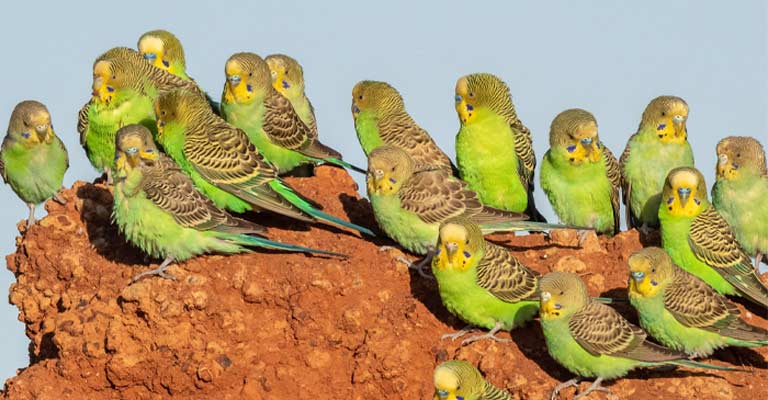
Budgerigars, or budgies, are popular as affectionate and social companion birds. Puffing up in budgies can signify different emotions, including relaxation, contentment, or even a response to colder temperatures.
Understanding the overall context of their environment and behavior aids in deciphering the meaning behind their puffing.
Cockatoos (Cacatuidae family)
Cockatoos, with their expressive crests and sociable nature, may puff up for reasons similar to other parrot species. Puffing up can be a sign of relaxation, warmth regulation, or even a response to social interactions within their flock.
Cockatoos are known for their playful and affectionate behaviors, and puffing up is just one way they communicate their feelings.
Lovebirds (Agapornis spp.)
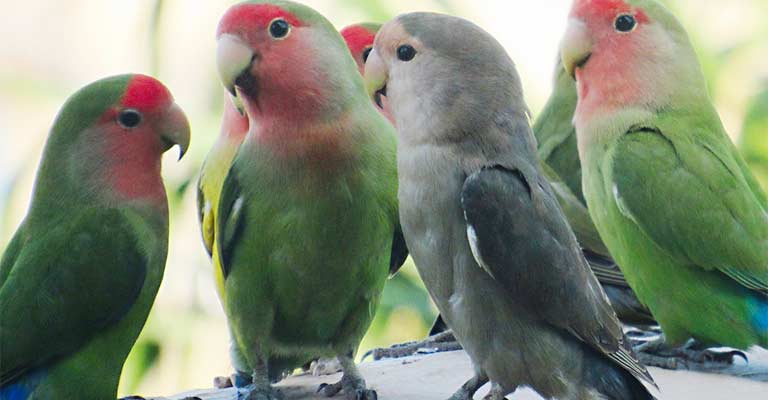
Lovebirds are small parrots known for forming strong bonds with their mates. Puffing up in lovebirds can be associated with various emotions, including contentment, relaxation, or even a display of affection.
Understanding the specific context, such as interactions with a mate or the environment, helps interpret the meaning behind their puffing.
Finches (Fringillidae family)
Various species of finches, appreciated for their colorful plumage and delightful songs, may puff up for different reasons. Puffing up in finches is often linked to temperature regulation and maintaining warmth, especially during periods of rest.
Observing their behavior in conjunction with their flock dynamics provides insight into the purpose of their puffing.
African Grey Parrots (Psittacus erithacus)
African Grey Parrots, known for their exceptional intelligence and ability to mimic speech, may puff up for a variety of reasons. Puffing up in African Greys can indicate comfort, relaxation, or even a response to social interactions.
Their complex communication skills make it essential to consider the broader context of their behavior to accurately interpret the meaning behind their puffing.
Understanding the reasons behind puffing up in various bird species requires considering their natural behaviors, environmental factors, and social dynamics within their respective flocks or pairs.
Regular observation and familiarity with each species’ characteristics contribute to a deeper understanding of their communication through puffing up.
What To Do If I See A Parrot Puffs Up?
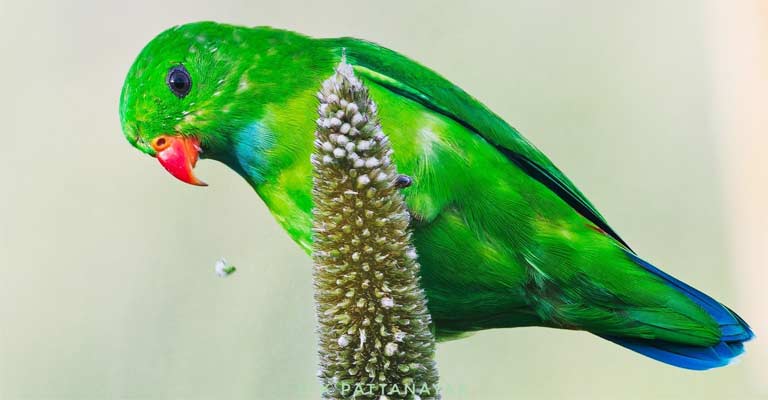
Here’s what to do if you see a parrot puffs up:
Monitor for Signs of Distress
The first step when you see a parrot puff up is to carefully monitor its overall behavior. If the puffing is accompanied by signs of distress, such as labored breathing, lethargy, or changes in appetite, it may indicate an underlying health issue.
Immediate veterinary attention is crucial to diagnose and address any potential health concerns.
Ensure Optimal Temperature
Parrots puff up as a natural response to regulate body temperature. If the environment is cold, ensure that the room temperature is comfortable for the bird. Provide additional warmth with a heat source or move the bird to a warmer area.
If the puffing persists in warmer temperatures, it may signal a health issue, warranting veterinary evaluation.
Evaluate the Bird’s Environment
Assess the parrot’s living environment for potential stressors, such as loud noises, sudden changes, or the presence of unfamiliar pets.
Create a calm and secure space, and ensure the bird has a variety of toys and perches for mental stimulation. Reducing stressors can positively impact the bird’s well-being.
Offer Social Interaction
Parrots are social creatures that thrive on interaction. Spend quality time with the bird, engaging in gentle activities, talking, or offering favorite treats.
Positive social interactions can alleviate stress and contribute to the bird’s overall contentment, potentially reducing puffing related to anxiety.
Check for Signs of Mating Behavior
Puffing up can be a part of normal mating behavior in parrots. If you have a pair of parrots, observe for other mating behaviors, such as regurgitation or courtship displays.
If the puffing is accompanied by these behaviors, it may be an expression of the bird’s natural instincts. Ensure that the conditions in the cage are suitable for potential nesting if applicable.
Maintain a Balanced Diet
Evaluate the parrot’s diet to ensure it is receiving a nutritionally balanced and species-appropriate meal. Nutritional deficiencies can impact a bird’s health and behavior.
Consult with a vet to review the diet and make any necessary adjustments or supplements to promote overall well-being.
Schedule a Veterinary Check-up
If you notice persistent puffing, especially if it is unrelated to environmental factors like temperature or social interactions, schedule a veterinary check-up.
A qualified avian veterinarian can conduct a thorough examination, including diagnostic tests, to identify and address any potential health issues.
Early intervention is crucial for maintaining the bird’s health and preventing the progression of any underlying conditions.
Understanding the context of a parrot’s puffing behavior and addressing potential stressors or health concerns promptly contribute to their overall well-being.
Regular veterinary check-ups, a stimulating environment, and positive social interactions are essential components of responsible parrot care.
FAQs
Why does my parrot puff up its feathers frequently?
Frequent feather puffing in parrots can indicate various things, including adjusting to environmental temperature, expressing contentment, or even signaling discomfort or illness. It’s essential to consider the overall context of the behavior, including the parrot’s environment and health, to interpret the meaning accurately.
Is it normal for a parrot to puff up?
Yes, it’s normal for parrots to puff up, and it can have different meanings. Puffing up helps them regulate body temperature, express relaxation, or signal well-being. However, any sudden or prolonged changes in behavior should be monitored.
Does puffing up always mean my parrot is sick?
Not necessarily. While puffing up can be a sign of illness or discomfort, it can also be a normal and healthy behavior. Monitoring for other signs, such as changes in appetite or activity level, helps determine whether veterinary attention is needed.
Can environmental factors cause a parrot to puff up?
Yes, environmental factors like temperature changes or stressors can cause a parrot to puff up. Puffing up is a natural response to adjust to colder temperatures or to signal unease.
Creating a calm and secure environment helps reduce stress-related puffing.
How can I tell if my parrot’s puffing up is a sign of distress?
Signs of distress accompanying puffing up may include changes in behavior, such as lethargy or loss of appetite and labored breathing. If you observe these signs, prompt veterinary attention is crucial to identify and address potential health issues.
Conclusion
The act of a parrot puffing up unfolds as a captivating chapter in the rich narrative of avian behavior.
Whether expressing comfort, adjusting to environmental conditions, or signaling potential health concerns, a puffing parrot communicates through a language woven with subtlety and significance.
As caregivers, recognizing the diverse meanings behind this behavior empowers us to provide the necessary care, address potential stressors, and prioritize the well-being of our feathered friends.
A puffing parrot is not merely a visual spectacle but a dynamic conversation, and our attentive response ensures a harmonious dialogue between humans and these intelligent, expressive creatures.